Liverpool – Besiktas 1:0
Liverpool proved the victor over a defensive Besiktas team which offered little in attack. Neither team excelled on the night but Liverpool were the superior team and controlled, yet they at times were found reliant on Ibe who, thankfully for Rodgers, excelled.
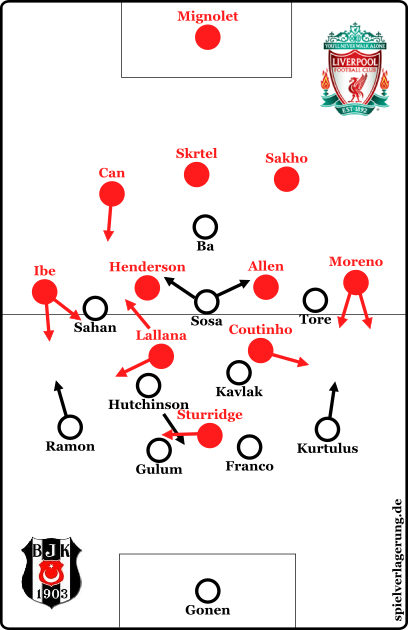
Initial formations
home side used their standard 3-4-2-1 system with a European debut for Sturridge upfront. He was backed up by Lallana and Coutinho who both had decent games, particularly when supporting wide players Ibe and Moreno. Henderson and Allen featured in central midfield whilst Mignolet was in goal behind a back 3 of Can, Sakho and Skrtel.
Besiktas lined up in a fairly orthodox 4-2-3-1 which was oriented quite largely to wide attacks. Gonen was in net with a back four of Ramon, Gulum, Franco and Kurtulus. They were supported in midfield by the Canadian Hutchinson and captain Veli Kavlak. In attack, Demba Ba lead the way with Jose Sosa, Tore and Sahan behind.
Besiktas Pressing
In defence, Bilic’s side employed a man-oriented zonal marking system, which turned to a standard man-marking system situationally.
The structure of Besiktas’ pressing was relatively flexible, as Hutchinson’s support often translated into a 4-1-4-1 with Kavlak as a lone 6. In these situations (often deeper Liverpool circulation), Hutchinson and Sosa were man-marking Henderson and Allen whilst Ba pressed the back 3. This gave more support against Liverpool’s Lallana and Coutinho who were dropping into spaces to aid the progression.
Alternatively, an orthodox 4-4-2 was formed. The front two’s role (Ba and Sosa) were often to block passes into the Henderson – Allen partnership of Liverpool, who were also usually marked by Besiktas’ central midfielders Hutchinson and Kavlak. As a result, the home side struggled to play through the deeper midfielders, however this didn’t have great impacts on the overall possession, as
Besiktas’ wide pressing was quite interesting, as they proved to be quite successful on the right side, whereas much less so on the left. This was largely due to individual performances, as Sahan made a poor defensive performance against Ibe whilst Can supported. He wasn’t helped however, by Demba Ba, whose pressing wasn’t as effective as Jose Sosa’s down the right side, especially in his cover shadowing of inside passes.
Liverpool 5-4-1 in Defence
Out of possession, Liverpool formed a 4-5-1 formation with Lallana and Coutinho moving to the sides of Allen and Henderson on the Besiktas full-backs. This was generally stable against a team which were poor in phases 2 and 3, and who arguably took the wrong strategy in the spaces they looked to attack.
In some situations, Liverpool’s shape lacked horizontal compaction in ball-far areas, which would have been exploited through intelligent diagonal passing however Besiktas didn’t offer great intelligence in their attacks. As I will come to talk about later, they lacked the ability to exploit obvious spaces which were often central. Through their persistence of wide attacking, Liverpool could easily orient themselves to focus on these situations instead of any central developments.
When the ball was wide, this open space was rarely exploited with Sosa also moving wide where Besiktas made 81% of their attacks.
The 3v1 in the back line was often overkill, however Sosa’s lack of presence centrally meant that a CB could follow Ba quite far without the fear of space behind being exploited, whilst the wide centre-backs had slightly more freedom in supporting the wing-back in defending wide areas.
Besiktas Ineffective Wing Orientation
The attacking strategy of Besiktas was seemingly to utilise wing combinations through the support of Sosa moving towards the flanks. Perhaps this was to exploit Liverpool’s 3-4-2-1 formation on paper, however they defended well on the touchline as they moved into a 5-4-1.
In my opinion, Bilic was disappointing here as a more effective route would have been to utilise the numerical advantage centrally, especially as Henderson and Allen aren’t very defensive-minded. In a number of occasions the space between midfield and attack was open as the Liverpool midfielders were oriented on Kavlak and Hutchinson, but only a few times was this exploited.
An example can be seen in the above diagram from the 5th minute. After a failed combination on the right wing, the ball is circulated back inside to Hutchinson, with the intention of moving it to Ramon and Sahan on the opposite side for a ‘different’ angle. The 10 space is open yet the only player in a position to access it is Ba who, because of the 3-man defensive line and lack of other players centrally, can easily be followed by Can with no consequences.
Not only this, the switch itself lacks pace Liverpool can shift very easily to increase compaction on the right, so Besiktas have far too inferior numbers to break through. As the ball comes back to the centre, Sosa can be seen reaching a position where he could link up with the left attack.
There were a number of scenes where the ball was with Hutchinson or Kavlak, and there were possibilities for vertical passes into the 10 space, yet they resorted to long diagonals which were easily defended.
Liverpool’s wide pressing was impressive, which must be given credit, as the wide midfield was often supported by the backwards pressing of Sturridge, cutting off the pressure relief, whilst the near CM and wing-back would also push into to cover most angles inside.
Liverpool in Attack and Ibe
Liverpool were also using wing play quite often, yet nowhere near the exclusiveness of Besiktas. The right side was favoured more as Ibe had dominance over Sahan, who struggled greatly to support the left-back Ramon.
These wide developments were supported well by Lallana and Coutinho moving into their respective half spaces, whilst the ball-near centre-back gave deeper support in co-ordination from the involvement of the near central midfielder. In right-sided situations, Sturridge sometimes made movements across also, which gave Ibe the impetus to cut inside on his runs, but could possibly have been better used in combination plays.
Liverpool perhaps didn’t utilise such overloads to as great a potential that they offered, especially on the right, but they made some good moments in combinations plays. Ibe’s inexperience was on display as he sometimes went for long runs instead of passing through the numerically-challenged Besiktas defence.
Besiktas 6-3-1
With Sahan (Frei) and Tore marking Ibe and Moreno respectively, Besiktas were often moved into a 6-3-1 in Liverpool’s 3rd phase, leading to a poor control centrally. This was in particular later on when Liverpool became more on-top.
Rodgers was poor in exploiting this through in-game changes I think. He seemed afraid of making a too expansive game at the possibility of conceding an away goal from a counter-attack, especially after Ba’s chance in the late second half.
An adaption which I would’ve liked to see would be to involve the ball-near centre-back more in phases 2 and 3 of possession. Emre Can in particular has proved successful in these moments yet he had much less inolvemnt in this game. By this, Can could support attacks through Ibe more but also help inside with the potential overloads involving Coutinho and Lallana.
Can would’ve been particularly successful I think, as Sahan was struggling greatly to support the left-back Ramon. His involvement would have been of a low risk, given the 3v1 situation in the back line – Liverpool would still have numerical superiority.
3-4-2-1 Becomes 3-4-1-2
Through Rodgers’ substitutions later on, he altered the system slightly to a 3-4-1-2 with Balotelli coming on in replacement of Coutinho, whilst Lovren came on for Joe Allen, meaning Emre Can took over his role. Although this had little influence on the shape, it altered the dynamics of their possession quite significantly which proved successful.
Can supported the first phase of possession to a greater extent than Allen, often being the lone midfielder dropping whilst Henderson could stay slightly higher. Through this, Liverpool facilitated an alternative, more direct style of play with Balotelli the target and Henderson, Lallana/Sterling and Sturridge moving off of him.
Conclusion
Overall, it was a relatively dull game with simple attacking strategies from Besiktas which were ineffective and dealt with easily by Liverpool, it would have definitely made a more interesting game Ba capitalised on his chance late in the second half.
Ibe was the one player who excelled on either team and ultimately was the difference between the two sides as he earned the penalty on one of his runs. His support from central players will be overlooked, where he could possibly have contributed to more threatening situations by playing as less of an individual. Nevertheless, Liverpool won 1-0 and he certainly made a big contribution in that.
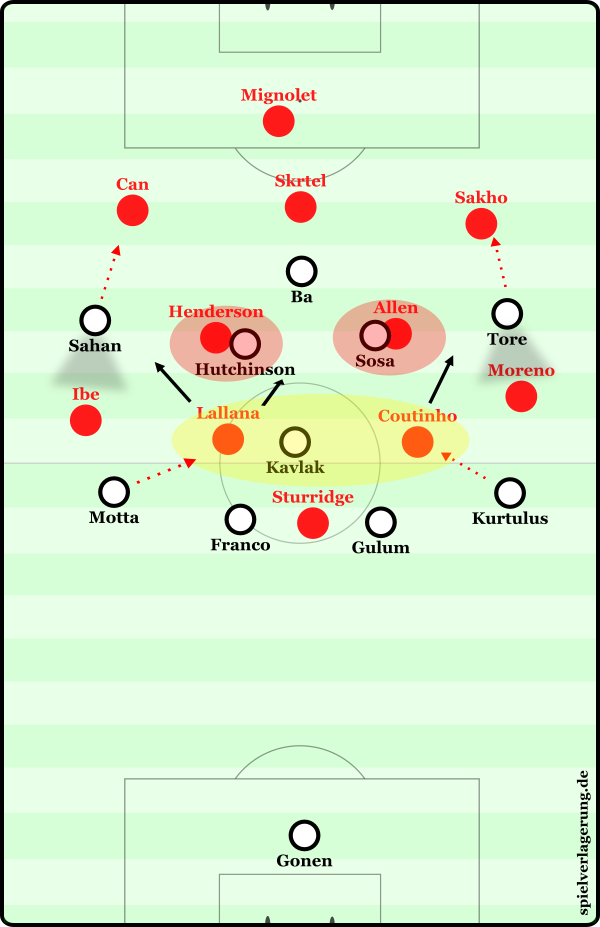
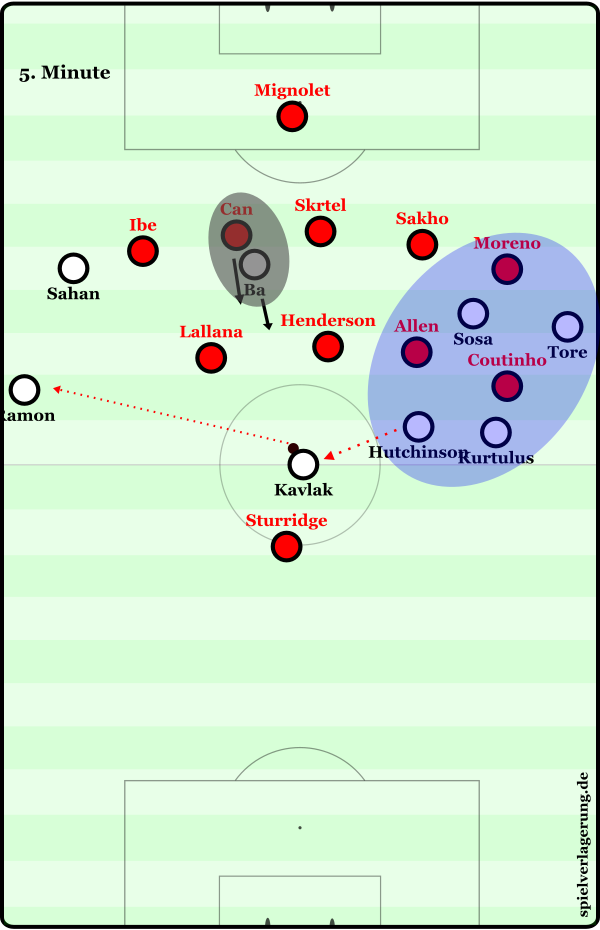
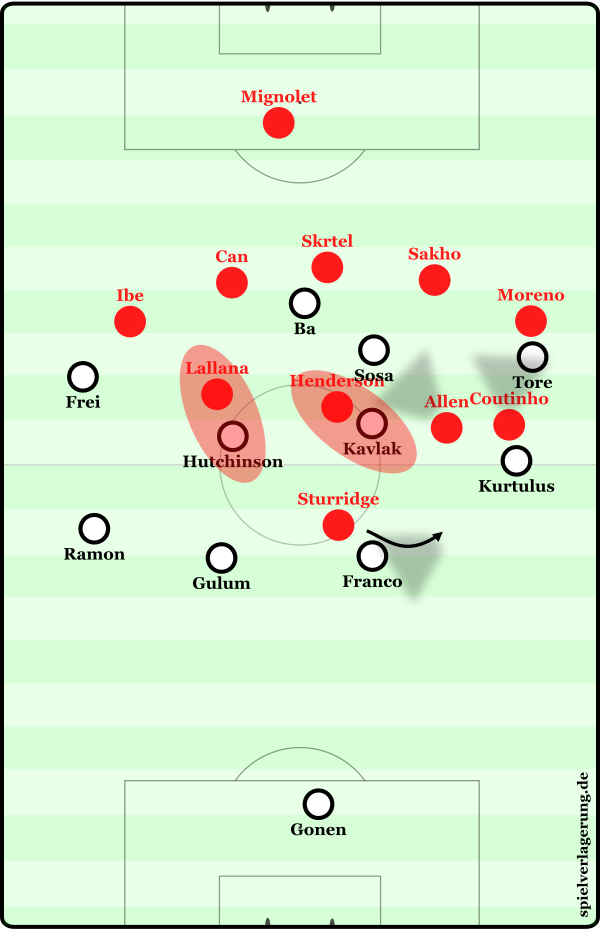
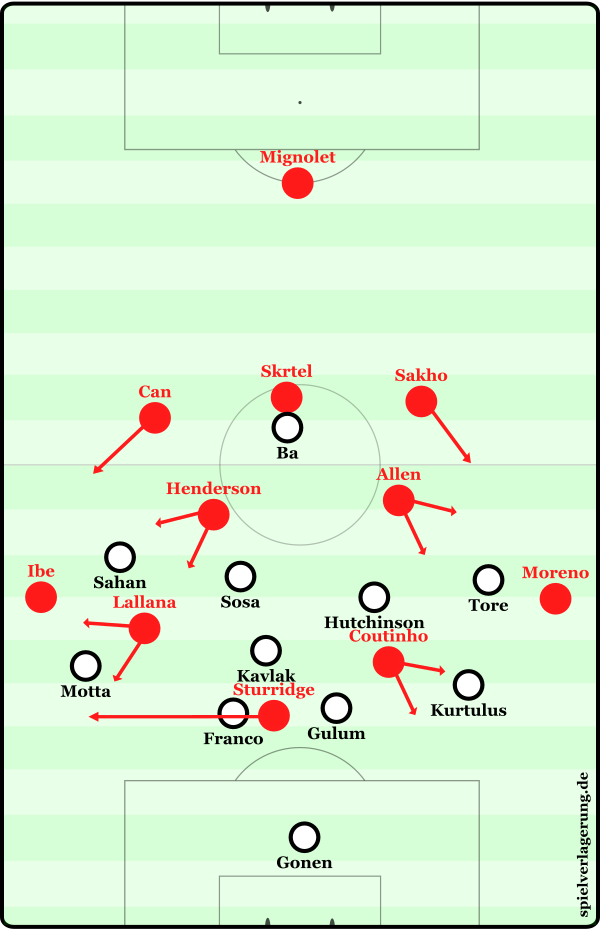

1 Kommentar Alle anzeigen
BD February 21, 2015 um 4:19 pm
Good article.
The 3421 formation is a good fit for Liverpool but it is way too static. Although the shape is good, there is barely any interchange of positions, and I’m not a friend of that. It becomes predictable and you are too dependent of the form of your key players. If they have an off-day or the opposition manages to nullify them you’ll struggle very much. I also have to say that the flow of the play was much better with Sterling up front. Sturridge’s decision making is quite slow and he tends to occupy the same spaces as Coutinho and Lallana do. He’s not at his best, though.